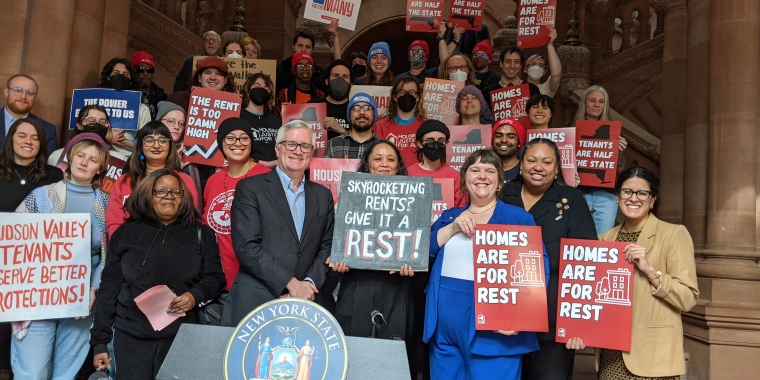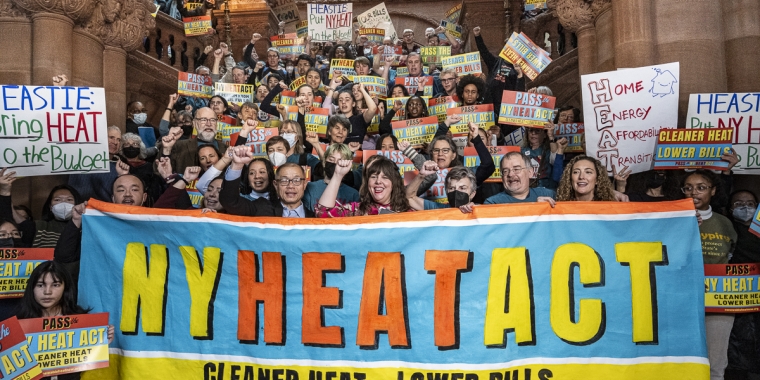Democratic lawmakers seek changes to rent regulation

A new bill would amend New York’s rent stabilization law, making it more friendly to upstate localities
ALBANY — Democratic lawmakers are scheduled to introduce legislation on Tuesday that could transform New York’s rent stabilization law, giving more options to localities across the state seeking to adopt the tenant protections.
The Rent Emergency Stabilization for Tenants Act, or REST Act, would amend the state’s Emergency Tenant Protection Act, a 1974 measure that let municipalities in Westchester, Rockland and Nassau counties opt-in to New York City’s rent stabilization laws for apartment buildings with at least six units built before that year. In 2019, the opt-in provision was expanded statewide as part of an overhaul of New York’s rental laws. The only way a locality can opt-in is to conduct a study showing a vacancy rate of 5% or lower in qualifying units, thus demonstrating a housing emergency.
That requirement for adopting the 1974 measures and the units it covers have not been updated for more than half a century, when they were written for the denser, older housing stock of New York City and its immediate suburbs. That has posed challenges for smaller localities, particularly in the Hudson Valley, that have struggled to conduct rigorous vacancy studies and faced legal challenges from landlords on that basis.
The REST Act would make the vacancy study optional and add alternative options for localities to adopt rent stabilization. According to the bill, which was shared exclusively with the Times Union prior to its introduction, local legislative bodies would be able to use a range of publicly available data — including rent rolls, overall housing supply, homelessness rates, median rents against income, and U.S. Census Bureau data — and hold public hearings to declare a housing emergency.
The bill also empowers localities to regulate rents in buildings with at least one rental unit, doing away with the current threshold of six units. Localities would choose where to draw the line as part of adopting the law.
Finally, the bill would update the provision that exempts buildings built after 1974 from being covered. Rather, the exemption window would be a rolling 15-year period, potentially bringing thousands more units per locality under rent stabilization.
State Sen. Brian Kavanagh, a lower Manhattan Democrat who chairs the chamber’s Committee on Housing, Construction and Community Development and cosponsors the REST Act, said the idea that determining a housing crisis based solely on vacancy rate is “antiquated.”
“We’re trying to modernize the law’s understanding of what constitutes a housing emergency,” Kavanagh said, citing rent stabilization laws in other states that consider a wider range of factors. “We have more and different types of data available now than in 1974.”
Kingston, Poughkeepsie and Newburgh were the first three cities to opt-in to the tenant protection act after the state Legislature expanded it in 2019. All three cities faced court challenges from a landlord group alleging errors in their vacancy studies. Kingston ultimately redid its vacancy study; last year, a state Appellate Court upheld the city’s law and a later rent reduction the city enacted, though the landlord group challenge it appealed to the state Court of Appeals in November. Courts struck down the law in Poughkeepsie and Newburgh. Other cities, including Albany and Rochester, have explored adopting the tenant protection act, but studies showed their vacancy rates were too high to opt-in.
Advocates and tenant-friendly lawmakers have been concerned about the tenant protection act’s suitability for smaller cities and towns outside New York City since at least 2018, when the latest push for rent reform began in Albany. That push led to the sweeping 2019 package. But Assemblywoman Sarahana Shrestha, a progressive Democrat from Esopus who sponsors the REST Act in the Assembly, said the current rent stabilization requirements make that law functionally “unusable” for most of the state. She noted that many smaller cities and towns lack the resources to conduct a vacancy study — most have outsourced it — or fight off subsequent legal challenges.
“The law should not be in the way of localities that want to protect their tenants,” Shrestha said.
Tenant advocates rallied at the state Capitol on Tuesday, alongside Kavanagh, Shrestha and other supportive lawmakers.
“Tenants are half the state and need immediate solutions to the cost-of-living crisis. Families across New York are living in fear of their next rent hike because price-gouging landlords and corporate real estate developers are raising rents sky-high,” said Cea Weaver, coalition director of the advocacy group Housing Justice for All. “By empowering local officials to stabilize rents, the REST Act will create long-term affordability in towns and cities around the state, protecting hundreds of thousands of tenants from price-gouging and displacement.”
Meanwhile, Rich Lanzarone, the executive director of the Hudson Valley Property Owners Association, which has filed lawsuits against local tenant protections up and down the Hudson Valley, chastised the legislation in a statement to the Times Union.
“This bill is an assault on mom-and-pop landlords from Buffalo to Montauk as it exempts the large landlords in New York City,” he said. “It doubles down on the 50-year failed record of rent stabilization in solving New York’s housing problems. The Emergency Tenant Protection Act hasn’t solved New York’s housing problems in the last 50 years and won’t solve the problems in the next 500 years.”
Lanzarone added that the state should scrap rent stabilization laws completely if it wants to address affordable housing. “Only then will New York’s awesome capital resources respond to pent-up demand and produce a surplus of housing, thereby driving rents down through market competition.”
While Kavanagh and Shrestha said they expect further pushback from New York’s influential real estate lobby, which has made passing statewide housing legislation difficult, they were optimistic about the REST Act’s chances this session. Shrestha said last year’s bruising fight to pass “good-cause” eviction at the state level could ease efforts for further tenant protections, especially when localities can set their own terms.
“When we were trying to pass ‘good-cause’ eviction, it was seen as this controversial thing that would break the housing market. Now that we’ve passed it and with an opt-in, we’ve seen there is an appetite for tenant protections,” Shrestha said, pointing to more than a dozen cities and towns that have adopted “good-cause” over the last year, including ones led by Republicans, such as Fishkill.
“We know there’s still a need for tenant protection we have not fulfilled,” she added. “This is the next step and a way for the state to not be in the way.”



